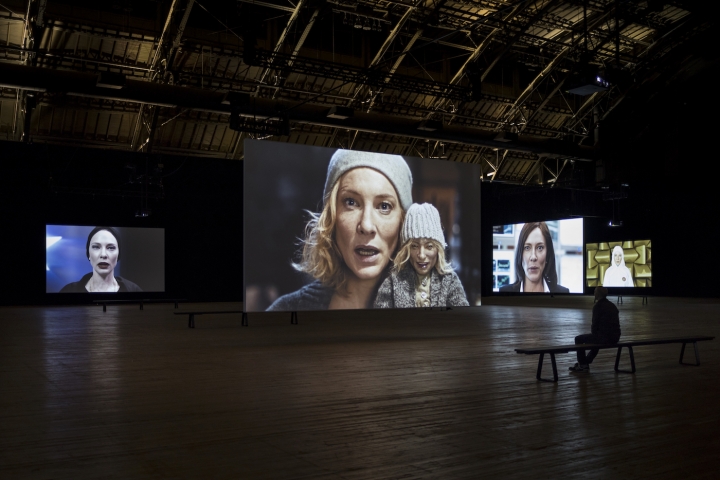by Carol Rocamora
Remember the amazing Christo Gates in 2005 that changed the way you viewed Central Park and the New York skyline? Now, only 10 years later, another new astonishing art installation has come along of mind-expanding magnitude. It’s called Manifesto, on view at the Park Avenue Armory – and don’t be put off by its academic-sounding title. It will be the most challenging, thrilling, and ultimately transforming artistic experience you’ve had in a decade.
Like Christo, cinematographer Julian Rosefeldt dares to go where angels fear to tread, and beyond. “What is art?” is the question Rosefeldt is posing in this unique work. To accomplish his purposes, this German video artist has taken excerpts from dozens of art manifestos written over the past century, combined them, placed them in the mouths of 12 ordinary, contemporary individuals, and videotaped them. Miraculously, actress Cate Blanchett conjures up each and every one of these people, bringing them to life on giant individual screens placed throughout the Armory’s cavernous interior.
This immersive, “total” artistic experience will take you approximately two hours. After a four-minute prologue, you’ll move from one screen to another, watching Blanchett morph miraculously from persona to persona in portraits that last 12 minutes each and replay continuously. First she’s a homeless man wandering through the ruins of Berlin, next she’s a imperious choreographer lecturing to dancers in a rehearsal hall, then she’s a deadbeat goth musician in a drug-filled studio, then she’s a stock broker on a brokerage floor, then she’s a scientist in a futuristic world, then she’s a machine operator in a garbage incinerator plant, and so on. Her physical and vocal transformations are phenomenal.
At first, the narrative that Blanchett recites has no apparent connection to the context to each individual scene. “I am for an art that doesn’t sit on its ass in a museum; I am for an art that runs and jumps,” says a housewife on one screen serving a roast chicken lunch to her family (actually, Blanchett’s own). “There should be a miracle in the creation of art,” says a speaker at a funeral on another screen. “All current art is fake because it lacks power, truth, passion,” says a TV anchorwoman on yet another screen.
But as you go from screen to screen and scene to scene, various leitmotifs emerge. “An old world is dying – a new world is being formed,” says the homeless man. “Life is the past and the future – but the present is art,” says a CEO at a cocktail party. “Imagination intimates what might be,” says a puppeteer in her workshop. “It’s not where you take things from, it’s where you take them to,” says a schoolteacher to her pupils.
The cumulative experience is a total one – of sight, sound, and physical space. Each scene is meticulously structured and symmetrical. His camera first glides over the specific location, then focuses on Blanchett. As her narrative crescendos to a penultimate moment, she lapses into a kind of hypnotic, robotic recitation. These vocal cadences are timed to happen simultaneously on all 12 giant screens, so wherever you’re sitting, you can see Blanchett’s numerous faces and hear her various voices at the same time. It’s an astonishing vision and a chorus of ideas unlike any you’ve ever heard. Call it an unearthly “music of the spheres.”
Rosefeldt has drawn from a broad range of texts – from artists, thinkers, and filmmakers, from Karl Marx to Claes Oldenburg to Lars von Trier to Jim Jarmusch. But in the end it’s not about what’s being quoted from abstract expressionists or dadaists or futurists or minimalists or surrealists. “I prefer richness in meaning rather than clarity in meaning,” says the machine operator. If there’s any meaning in Manifesto, it’s in the richness and totality of this unique artistic experience.
“What we need is works of art beyond understanding,” says the funeral orator.
I don’t pretend to understand this complex, profound work of genius that Rosefeldt and Blanchett have created together. But by the time I left the Armory, I felt I’d done what these brilliant collaborators intended. And that is: Look. Listen. Hear. Open your mind. And then, like the schoolchildren in the last moving video who run free around the playground, go back to work revitalized. See art in the world anew, and the world in art.
Manifesto, by Julian Rosefeldt with Cate Blanchett, at the Park Avenue Armory, now through January 8
Photo: James Ewing



















